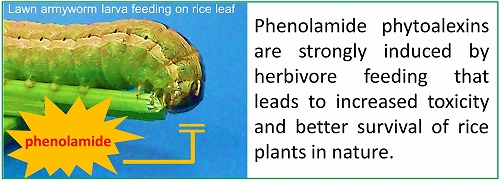
新着情報
Rice plants defend from herbivores by production of phenolamide phytoalexins
[著者] Kabir Md Alamgir, Yuko Hojo, John T. Christeller, Kaori Fukumoto, Ryutaro Isshiki, Tomonori Shinya, Ian T. Baldwin, Ivan Galis
[発表タイトル] Systematic analysis of rice (Oryza sativa) metabolic responses to herbivory
[掲載論文] Plant, Cell and Environment: [Epub ahead of print] (2015)doi: 10.1111/pce.12640
http://onlinelibrary.wiley.com/doi/10.1111/pce.12640/full
[使用した共通機器] LC-MS/MS
[共同研究] In collaboration with the Max Planck Institute for Chemical Ecology, Jena, Germany
[内容紹介] Most plants respond to herbivore attack and wounding by production of protective defense metabolites (phytoalexins). We analyzed response of rice plants to two types of herbivores, chewing (lawn armyworm Spodoptera mauritia, rice skipper Parnara guttata) and sucking (brown planthopper Nilaparvata lugens) insects. Both attackers induced strong accumulation of phenolamide phytoalexins in the leaves. In addition, these phenolamides were directly toxic to brown planthoppers when added to artificial diet used for rearing of these insects in the laboratory. Our work proposed a new group of defense compounds in rice that is highly effective against various types of insects. It also provided a potentially new tool for the improvement of herbivore-susceptible rice cultivars by genetically increasing their endogenous phenolamide levels during critical stages of development. (文責 Ivan Galis)
お問い合わせ先: 植物・昆虫間相互作用グループ






